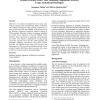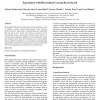MEDINFO
2007
13 years 5 months ago
2007
The nature of the internet as a non-peer-reviewed (and more generally largely unregulated) publication medium has allowed wide-spread promotion of inaccurate and unproven medical ...
MEDINFO
2007
13 years 5 months ago
2007
Objective: To apply and compare common machine learning techniques with an expert-built Bayesian Network to determine eligibility for asthma guidelines in pediatric emergency depa...
MEDINFO
2007
13 years 5 months ago
2007
Objectives: To compare the alignments of two large anatomical ontologies (the Foundational Model of Anatomy and GALEN) produced by three ontology alignment systems (AOAS, FALCON a...
MEDINFO
2007
13 years 5 months ago
2007
Temporal constraints play a fundamental role in clinical guidelines. For example, temporal indeterminacy, constraints about duration, delays between actions and periodic repetitio...
MEDINFO
2007
13 years 5 months ago
2007
In 2005, a major collaboration in Melbourne Australia successfully completed implementing a major medical informatics infrastructure – this is now being used for discovery resear...
MEDINFO
2007
13 years 5 months ago
2007
Reuse of ontologies is important for achieving better interoperability among health systems and relieving knowledge engineers from the burden of developing ontologies from scratch...
MEDINFO
2007
13 years 5 months ago
2007
Medical language, as many technical languages, is rich with morphologically complex words, many of which take their roots in Greek and Latin—in which case they are called neocla...
MEDINFO
2007
13 years 5 months ago
2007
Ongoing concerns have been raised over the effectiveness of information technology products and systems in maintaining privacy protection for sensitive data. The aim is to ensure ...
MEDINFO
2007
13 years 5 months ago
2007
Many digital libraries use hierarchical indexing schema, such as MeSH to enable concept based search in the retrieval phase. However, improving or outperforming the traditional fu...
MEDINFO
2007
13 years 5 months ago
2007
Standardization of data is a prerequisite to achieve semantic interoperability in any domain. This is even more important in the healthcare sector where the need for exchanging he...


